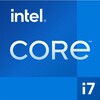AMD Ryzen 7 6800H vs Intel Core i7-1270P vs AMD Ryzen 9 PRO 6950H
AMD Ryzen 7 6800H
► remove from comparison
The AMD Ryzen 7 6800H is a processor for big (gaming) laptops based on the Rembrandt generation. The R7 6800H integrates all eight cores based on the Zen 3+ microarchitecture. They are clocked at 3.2 (guaranteed base clock) to 4.7 GHz (Turbo) and support SMT / Hyperthreading (16 threads). The chip is manufactured on the modern 6 nm TSMC process.
The new Zen 3+ is a refresh of the Zen 3 architecture and should not offer a lot of changes. The chip itself however, offers a lot of new features, like support for USB 4 (40 Gbps), PCI-E Gen 4, DDR5-4800MT/s or LPDDR5-6400MT/s, WiFi 6E, Bluetooth LE 5.2, DisplayPort 2, and AV1 decode.
A big novelty is the integrated GPU Radeon 680M that is now based on the RDNA2 architecture and offers 12 CUs at up to 2.2 GHz. It should be the fastest iGPU of all at the time of announcement.
Performance
The average 6800H in our database is in the same league as the Core i5-12500H and the Core i7-12650H, as far as multi-thread benchmark scores are concerned. The Ryzen 9 5900HX is found close nearby as well.
Thanks to its decent cooling solution and a long-term CPU power limit of 90 W, the Legion 5 Pro 16ARH7H is among the fastest systems built around the 6800H that we know of. It can be about 60% faster in CPU-bound workloads than the slowest system featuring the same chip in our database, as of August 2023.
Power consumption
This Ryzen 7 series chip has a default TDP, also known as the long-term power limit, of 45 W. An active cooling solution is a must for a CPU like this.
The R7 6800H is built with TSMC's 6 nm manufacturing process for above average, as of mid 2023, energy efficiency.
Intel Core i7-1270P
► remove from comparison
The Intel Core i7-1270P is a higher-end Alder Lake-P family CPU, an expensive 28 W part meant for use in ultra-light, ultra-thin (yet actively cooled) laptops. This CPU was announced in early 2022 and it has 4 performance cores as opposed to the 6 cores of the top-of-the-line 1280P (P-cores, Golden Cove architecture) mated to 8 efficient cores (E-cores, Gracemont architecture). The P-cores are Hyper-Threading-enabled for a total of 16 threads when combined with the E-cores. The clock speeds range from 2.2 GHz to 4.8 GHz for the performance cluster and 1.6 GHz to 3.5 GHz for the efficient cluster. Full vPro feature set is supported by this Core i7 ("Enterprise" tier, allowing for remote device management). Its shortcomings as compared with the mighty i7-1280P include the smaller L3 cache, lower core count, lower clock speeds; the performance is slated to be significantly lower as a result.
A brief look at the specifications instantly reveals this i7 series chip to be very similar to the Core i5-12600H, a more power-hungry processor targeted at gaming laptops.
Architecture
The i7 is a continuation of Intel's efforts to use the ARM-developed big.LITTLE technology for its own benefit. A single "little" Alder Lake core is supposed to be as fast as a Skylake core (as found in the venerable Core i7-6700HQ among other options) which is six years old at this point. All of an Intel Core i7-1270P's CPU cores enjoy access to 18 MB of L3 cache. The integrated memory controller supports various memory types up to LPDDR5-5200, DDR5-4800, LPDDR4x-4267 or DDR4-3200. Intel suggests using no more than 64 GB, for reference. Just like the other 12th Gen Intel Core processors, Core i7-1270P comes with Thread Director which is a new functionality designed to help Windows 11 decide which cores to use for what workload for best performance and efficiency possible. Hardware acceleration of AI algorithms is supported via GNA 3.0 and DL Boost (via AVX2). PCI-Express 5.0 support has not found its way into Alder Lake P processors, so users will have to be content with PCI-Express 4.0 for the time being. Four PCI-Express 4 lanes allow for a read/write rate of up to 7.9 GB/s, provided a suitably fast NVMe SSD is used.
Please note this is not a user-replaceable CPU. It gets soldered permanently on to the motherboard (BGA1744 socket interface).
Performance
The 12 CPU cores are not just able to outshine any outgoing quad-core Tiger Lake part, the i7-1195G7 included. The average 1270P in our database directly competes with the Ryzen 7 5825U, the Ryzen 7 7730U and the Ryzen 7 7735U, meaning this little Core i7 is fast enough to make most consumers happy as of mid 2023.
The fairly high processing power comes at a cost. A single Golden Cove core can consume more than 20 W when under heavy load. Your mileage may thus vary depending on how high the Power Limits are and how competent the cooling solution of your laptop is.
Graphics
The built-in graphics adapter in the form of the 96 EU Iris Xe running at up to 1.40 GHz has seen no change from what was built into the 11th Gen Tiger Lake-UP3 processors, like an i7-1165G7, which is hardly a downside as this iGPU is loaded with modern features such as AV1 video decoding capability and SUHD 4320p monitor support. Up to 4 monitors can be used simultaneously with this iGPU. We expect the gaming performance to be reasonably close to that of NVIDIA's MX350.
In other words, the Xe is good enough for most games at 1080p resolution / Medium settings, provided the Power Limits are high enough and the cooling solution is competent enough. Fast RAM is a prerequisite for decent performance as well (the Xe has to make do with no dedicated video memory).
Last but not the least, we discovered that the GPU utilization when playing YouTube UHD 2160p60 videos is higher than it was with Tiger Lake chips.
Power consumption
The i7's base power consumption (also known as the default TDP or Power Limit 1) is 28 W, with 64 W being its maximum Turbo power consumption (also known as the PL2). As for the "Minimum Assured" power consumption, Intel's guidelines mention 20 W. All in all, an active cooling solution is a must for such a chip.
The CPU is built with Intel's fourth-gen 10 nm process marketed as Intel 7 for decent, as of late 2022, energy efficiency. It's still a rather power-hungry CPU; a single P-core will happily consume more than 20 W when under heavy load. A couple of the higher-end 7 nm U-class AMD Ryzen 5000 chips are not nearly as power-hungry while delivering similar or higher performance levels.
AMD Ryzen 9 PRO 6950H
► remove from comparison
The AMD Ryzen 9 PRO 6950H is a processor for big (workstation) laptops based on the Rembrandt generation. The R9 6900HX integrates all eight cores based on the Zen 3+ microarchitecture. They are clocked at 3.3 (guaranteed base clock) to 4.9 GHz (Turbo) and support SMT / Hyperthreading (16 threads). The chip is manufactured on the modern 6 nm TSMC process. The 6950H is the professional version of the consumer R9 6900HX without overclocking features but with additional management features and the Microsoft Pluton Security processor.
The new Zen 3+ architecture is a refresh of the Zen 3 architecture and should not offer a lot of changes. The chip itself however, offers a lot of new features, like support for USB 4 (40 Gbps), PCI-E Gen 4, DDR5-4800MT/s or LPDDR5-6400MT/s, WiFi 6E, Bluetooth LE 5.2, DisplayPort 2, and AV1 decode.
A big novelty is the integrated GPU Radeon 680M, that is now based on the RDNA2 architecture and offers 12 CUs at up to 2.4 GHz. It should be the fastest iGPU of all at the time of announcement.
Performance
While we have not tested a single system built around the 6950H as of August 2023, we have tested one system featuring the 6950HS, its slightly more power-efficient brother. Based on that, expect the 6950H to be slightly faster than the Ryzen 7 5800H, Ryzen 9 4900H, Ryzen 5 PRO 7640HS and also the Core i7-11800H. In other words, this is a higher-end chip that will handle almost any task with ease, as of late 2022.
Your mileage may vary depending on how competent the cooling solution of your laptop is and how high the CPU power limits are.
Power consumption
This Ryzen has a default TDP of 45 W (also known as the PL1). A high-performance cooling solution is a must for a CPU like this one here.
Ryzen 9 PRO 6950H is built with TSMC's 6 nm process leading to great, as of late 2022, energy efficiency.
| Model | AMD Ryzen 7 6800H | Intel Core i7-1270P | AMD Ryzen 9 PRO 6950H | ||||||||||||||||||||||||||||||||||||||||||||||||||||||||||||||||||||||||||||||||
| Codename | Rembrandt-H (Zen 3+) | Alder Lake-P | Rembrandt-H (Zen 3+) | ||||||||||||||||||||||||||||||||||||||||||||||||||||||||||||||||||||||||||||||||
| Series | AMD Rembrandt (Zen 3+) | Intel Alder Lake-P | AMD Rembrandt (Zen 3+) | ||||||||||||||||||||||||||||||||||||||||||||||||||||||||||||||||||||||||||||||||
| Series: Rembrandt (Zen 3+) Rembrandt-H (Zen 3+) |
|
|
| ||||||||||||||||||||||||||||||||||||||||||||||||||||||||||||||||||||||||||||||||
| Clock | 3200 - 4700 MHz | 1600 - 4800 MHz | 3300 - 4900 MHz | ||||||||||||||||||||||||||||||||||||||||||||||||||||||||||||||||||||||||||||||||
| L1 Cache | 512 KB | 1.1 MB | |||||||||||||||||||||||||||||||||||||||||||||||||||||||||||||||||||||||||||||||||
| L2 Cache | 4 MB | 10 MB | 4 MB | ||||||||||||||||||||||||||||||||||||||||||||||||||||||||||||||||||||||||||||||||
| L3 Cache | 16 MB | 18 MB | 16 MB | ||||||||||||||||||||||||||||||||||||||||||||||||||||||||||||||||||||||||||||||||
| Cores / Threads | 8 / 16 | 12 / 16 | 8 / 16 | ||||||||||||||||||||||||||||||||||||||||||||||||||||||||||||||||||||||||||||||||
| TDP | 45 Watt | 28 Watt | 45 Watt | ||||||||||||||||||||||||||||||||||||||||||||||||||||||||||||||||||||||||||||||||
| Technology | 6 nm | 10 nm | 6 nm | ||||||||||||||||||||||||||||||||||||||||||||||||||||||||||||||||||||||||||||||||
| max. Temp. | 95 °C | 100 °C | 95 °C | ||||||||||||||||||||||||||||||||||||||||||||||||||||||||||||||||||||||||||||||||
| Socket | FP7/FP7r2 | BGA1744 | FP7/FP7r2 | ||||||||||||||||||||||||||||||||||||||||||||||||||||||||||||||||||||||||||||||||
| Features | DDR5-4800/LPDDR5-6400 RAM (incl. ECC), PCIe 4, MMX, SSE, SSE2, SSE3, SSSE3, SSE4A, SSE4.1, SSE4.2, AVX, AVX2, BMI2, ABM, FMA, ADX, SMEP, SMAP, SMT, CPB, AES-NI, RDRAND, RDSEED, SHA, SME | DDR4-3200/LPDDR4x-4266/DDR5-4800/LPDDR5-5200 RAM, PCIe 4, Thr. Director, DL Boost, GNA, Rem. Platf. Erase, MMX, SSE, SSE2, SSE3, SSSE3, SSE4.1, SSE4.2, AVX, AVX2, BMI2, ABM, FMA, ADX, SMEP, SMAP, EIST, TM1, TM2, HT, Turbo, SST, AES-NI, RDRAND, RDSEED, SHA | DDR5-4800/LPDDR5-6400 RAM (incl. ECC), PCIe 4, PRO, MMX, SSE, SSE2, SSE3, SSSE3, SSE4A, SSE4.1, SSE4.2, AVX, AVX2, BMI2, ABM, FMA, ADX, SMEP, SMAP, SMT, CPB, AES-NI, RDRAND, RDSEED, SHA, SME | ||||||||||||||||||||||||||||||||||||||||||||||||||||||||||||||||||||||||||||||||
| iGPU | AMD Radeon 680M ( - 2200 MHz) | Intel Iris Xe Graphics G7 96EUs ( - 1400 MHz) | AMD Radeon 680M ( - 2400 MHz) | ||||||||||||||||||||||||||||||||||||||||||||||||||||||||||||||||||||||||||||||||
| Architecture | x86 | x86 | x86 | ||||||||||||||||||||||||||||||||||||||||||||||||||||||||||||||||||||||||||||||||
| Announced | |||||||||||||||||||||||||||||||||||||||||||||||||||||||||||||||||||||||||||||||||||
| Manufacturer | www.amd.com | ark.intel.com | www.amd.com |
Benchmarks
Average Benchmarks AMD Ryzen 7 6800H → 100% n=22
Average Benchmarks Intel Core i7-1270P → 84% n=22
Average Benchmarks AMD Ryzen 9 PRO 6950H → 103% n=22
* Smaller numbers mean a higher performance
1 This benchmark is not used for the average calculation













